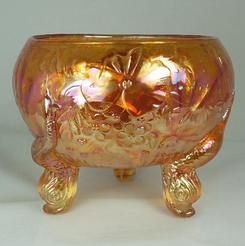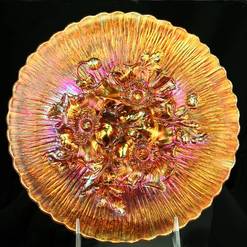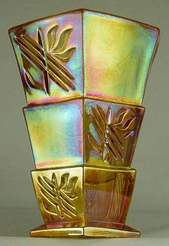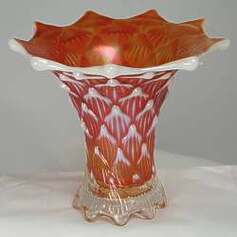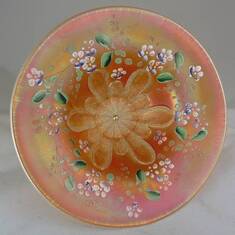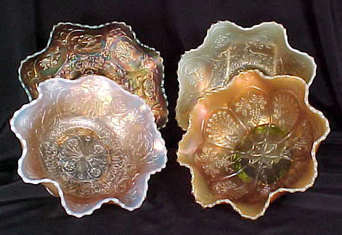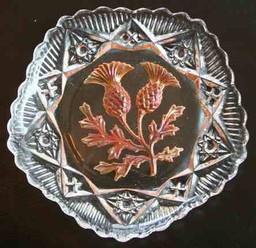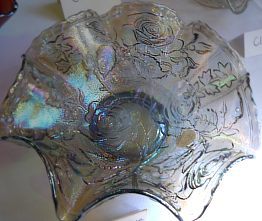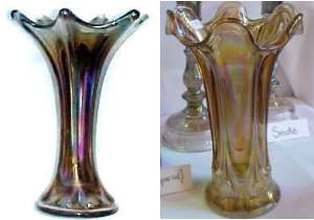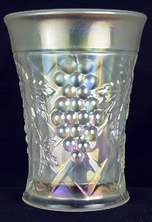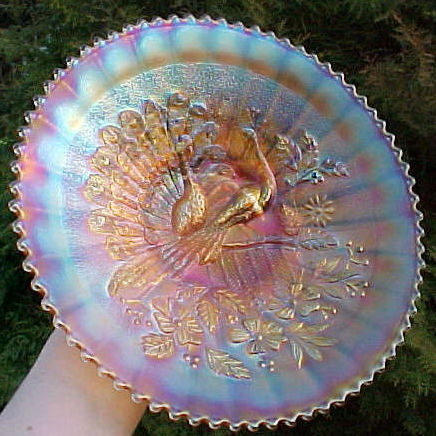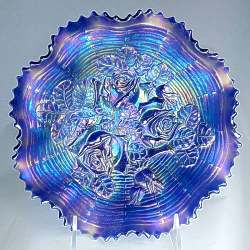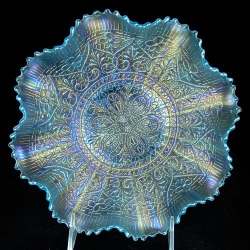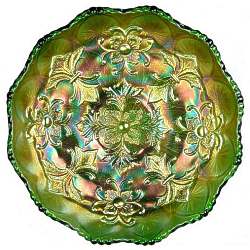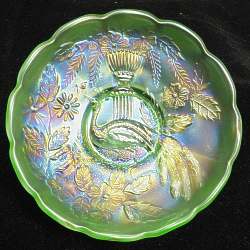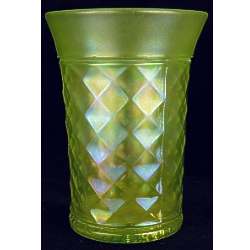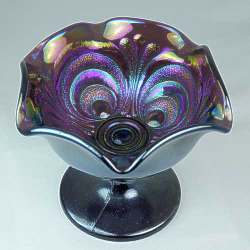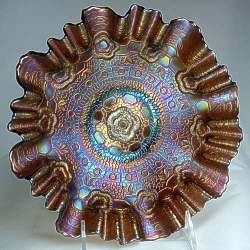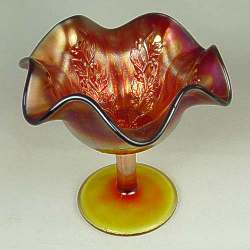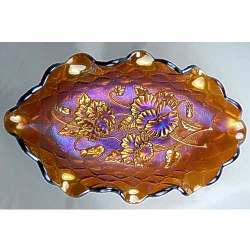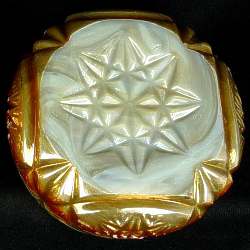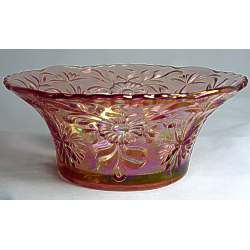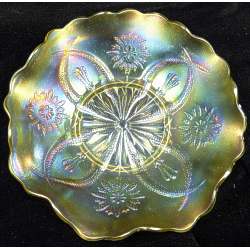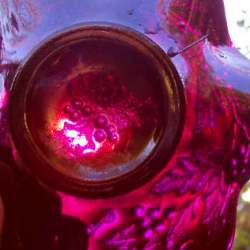Carnival Glass Colours - Marigold, Clear White and Smoke
Every Carnival Glass maker produced marigold. It was surely the most popular colour, possibly because it looked good against dark furniture, enlivened homes and was similar in appearance to some of the more expensive art glass. The crucial and essential characteristic of marigold is that the base glass is clear.
But what exactly is marigold? Simply put, it is clear glass with an orange iridescence. The orange colour that collectors call marigold comes wholly from the metal salts (iron chloride) in the iridescent spray (sometimes referred to as “dope”).
Harry Northwood explained: "Ordinary Chloride of Iron as bought at wholesale drug stores costs 3½ cents a lb. ... spray on glass when finished ready for lehr... glass must be fairly hot."* Harry added that "Spray on glass very hot for Matt Iridescent and not so hot for Bright Iridescent" which is how the satin (matt) and radium (bright) effects were achieved on Carnival Glass.
Harry added a very interesting comment, that spraying iron chloride on hot glass, quickly followed by a second spraying with a tin solution "gives beautiful effects". The tin solution is stannous chloride, which is used by glassmakers today to produce shimmering iridescent effects that are often quite light and without the heavy “staining” produced by the iron salts. It seems likely that this double doping of a light iron chloride spray followed by a stannous chloride spray may have produced the magnificent effect known as pastel marigold. (Source: Harry Northwood, The Wheeling Years: Heacock, Measell and Wiggins.)
How did marigold get its name? That's quite a long story, and the answer may surprise you. Read the Story Behind the Glass: marigold.
(Standard) Marigold is the most commonly found Carnival colour. It comes in all shades from a deep orangey colour to very pale, almost “wishy washy” marigold. Do not confuse pale marigold with pastel marigold. Wishy-washy marigold is silvery and pale, with no other colours in the iridescence.
Pastel marigold – multi-hued highlights shimmer on pastel marigold. There are limes, purples, pinks, turquoise and more. One of Josef Inwald's specialities was a dazzling pastel marigold, indicative of the factory's high quality work. For a much more detailed look at pastel marigold, go here: Pastel Marigold.
Pumpkin marigold – rich, vibrant, deep tones show in the iridescence: purple, red, orange and more.
But what exactly is marigold? Simply put, it is clear glass with an orange iridescence. The orange colour that collectors call marigold comes wholly from the metal salts (iron chloride) in the iridescent spray (sometimes referred to as “dope”).
Harry Northwood explained: "Ordinary Chloride of Iron as bought at wholesale drug stores costs 3½ cents a lb. ... spray on glass when finished ready for lehr... glass must be fairly hot."* Harry added that "Spray on glass very hot for Matt Iridescent and not so hot for Bright Iridescent" which is how the satin (matt) and radium (bright) effects were achieved on Carnival Glass.
Harry added a very interesting comment, that spraying iron chloride on hot glass, quickly followed by a second spraying with a tin solution "gives beautiful effects". The tin solution is stannous chloride, which is used by glassmakers today to produce shimmering iridescent effects that are often quite light and without the heavy “staining” produced by the iron salts. It seems likely that this double doping of a light iron chloride spray followed by a stannous chloride spray may have produced the magnificent effect known as pastel marigold. (Source: Harry Northwood, The Wheeling Years: Heacock, Measell and Wiggins.)
How did marigold get its name? That's quite a long story, and the answer may surprise you. Read the Story Behind the Glass: marigold.
(Standard) Marigold is the most commonly found Carnival colour. It comes in all shades from a deep orangey colour to very pale, almost “wishy washy” marigold. Do not confuse pale marigold with pastel marigold. Wishy-washy marigold is silvery and pale, with no other colours in the iridescence.
Pastel marigold – multi-hued highlights shimmer on pastel marigold. There are limes, purples, pinks, turquoise and more. One of Josef Inwald's specialities was a dazzling pastel marigold, indicative of the factory's high quality work. For a much more detailed look at pastel marigold, go here: Pastel Marigold.
Pumpkin marigold – rich, vibrant, deep tones show in the iridescence: purple, red, orange and more.
The effects of opalescence
By reheating glass which has a reactive component such as bone ash, the heat-reactive parts turn white. These are usually on the edges or highest/thickest parts. Many base glass colours become further diversified (or complicated, if you prefer) by the extra quality of opalescence. Thus we have….peach opal(escent), aqua opal, amethyst opal, blue opal, red opal and so on.
Peach opal(escent) – essentially this is marigold with a white opalescent edge. Note it also shows the same variations in colour as marigold (pale, pastel, pumpkin, etc). Dugan was the main producer of peach opal, and sometimes they used added an enamelled decoration (see below).
|
Marigold and Clear
We can't leave marigold without showing the so-called "Golden" Patterns - patterns where the moulded design (on the underside of the base) is marigold and the rest of the piece is clear glass. Note: there are also examples where the pattern is clear and the rest of the piece is marigold. Two Golden Patterns are shown, right - Golden Thistle, and Butterfly Catcher. We have researched these pieces over many years and we found that the maker of most of them was Zabkowice in Poland. Over 20 patterns have been identified and shared in our major, new four part exposé. Read all about the Golden Patterns in Golden Treasures. |
Clear – no base colour but with a pastel iridescence
White – clear base glass with a frosty, acid-treated, pastel iridescence
Smoke – the colour “smoke” is quite a complex area in which both iridescence and base colour may vary. Although most smoke is found on clear base glass, smoke iridescence can also be found on grey, brown-grey or even blue-grey and milk glass. The iridescence usually has a predominant “smokey” effect but can vary from smoky yellow and brown effects, through grey to blue-grey and even greenish smoke effects. Brown smoke iridescence on clear base glass can be quite close to the colour clambroth. Our sincere thanks to Joan Doty for her research on smoke and amber which highlighted how the iridescence on these pieces created the variations of colour and tone.
White – clear base glass with a frosty, acid-treated, pastel iridescence
Smoke – the colour “smoke” is quite a complex area in which both iridescence and base colour may vary. Although most smoke is found on clear base glass, smoke iridescence can also be found on grey, brown-grey or even blue-grey and milk glass. The iridescence usually has a predominant “smokey” effect but can vary from smoky yellow and brown effects, through grey to blue-grey and even greenish smoke effects. Brown smoke iridescence on clear base glass can be quite close to the colour clambroth. Our sincere thanks to Joan Doty for her research on smoke and amber which highlighted how the iridescence on these pieces created the variations of colour and tone.
Click on any image to look at more colours
